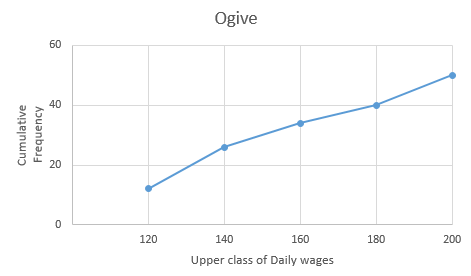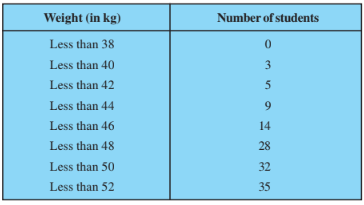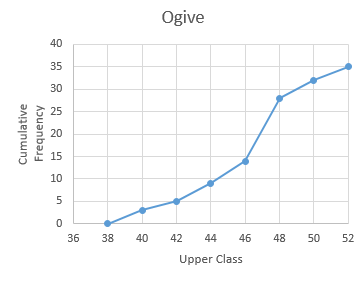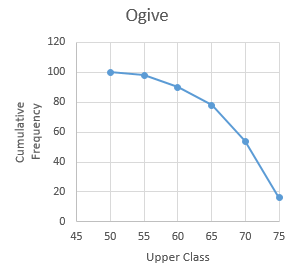Benefits of NCERT Solutions for Class 10 Maths Exercise 14.4
Q1 The following distribution gives the daily income of 50 workers of a factory.
 Convert the distribution above to a less than type cumulative frequency distribution, and draw its ogive.
Convert the distribution above to a less than type cumulative frequency distribution, and draw its ogive.
Answer:
Daily Income (Upper-Class Limit) | Cumulative Frequency |
Less than 120 | 12 |
Less than 140 | 26 |
Less than 160 | 34 |
Less than 180 | 40 |
Less than 200 | 50 |
Now,
Taking upper-class interval on the x-axis and their respective frequencies on the y-axis,

Q2 During the medical check-up of 35 students of a class, their weights were recorded as follows:
 Draw a less than type ogive for the given data. Hence obtain the median weight from the graph and verify the result by using the formula.
Draw a less than type ogive for the given data. Hence obtain the median weight from the graph and verify the result by using the formula.
Answer:
Taking upper-class interval on the x-axis and their respective frequencies on the y-axis,

$N= 35 \implies \frac{N}{2} = 17.5$
Marking a point on the curve whose ordinate is 17.5 gives an x-ordinate= 46.5.
Hence, the Median of the data is 46.5
Now,
Weight (Class) | Frequency | Cumulative Frequency |
>38 | 0 | 0 |
38-40 | 3 | 3 |
40-42 | 2 | 5 |
42-44 | 4 | 9 |
44-46 | 5 | 14 |
46-48 | 14 | 28 |
48-50 | 4 | 32 |
50-52 | 3 | 35 |
$N= 35 \implies \frac{N}{2} = 17.5$
$\therefore$ Median class = 46-48; Lower limit, l = 46;
Cumulative frequency of preceding class, c.f. = 14; f = 14; h = 2
$Median = l + \left (\frac{\frac{n}{2}-c.f}{f} \right ).W$
$\\ = 46+ \left (\frac{17.5-14}{14} \right ).2 \\ \\ = 46+\frac{7}{14}$
$= 46.5$
Thus, the median using formula is 46.5 which verifies the result.
Q3 The following table gives production yield per hectare of wheat of 100 farms of a village.
 Change the distribution to a more than type distribution, and draw its ogive.
Change the distribution to a more than type distribution, and draw its ogive.
Answer:
Production yield (Upper-Class Limit) | Cumulative Frequency |
More than or equal to 50 | 100 |
More than or equal to 55 | 98 |
More than or equal to 60 | 90 |
More than or equal to 65 | 78 |
More than or equal to 70 | 54 |
More than or equal to 75 | 16 |
Now,
Taking lower class limit on the x-axis and their respective frequencies on the y-axis,



